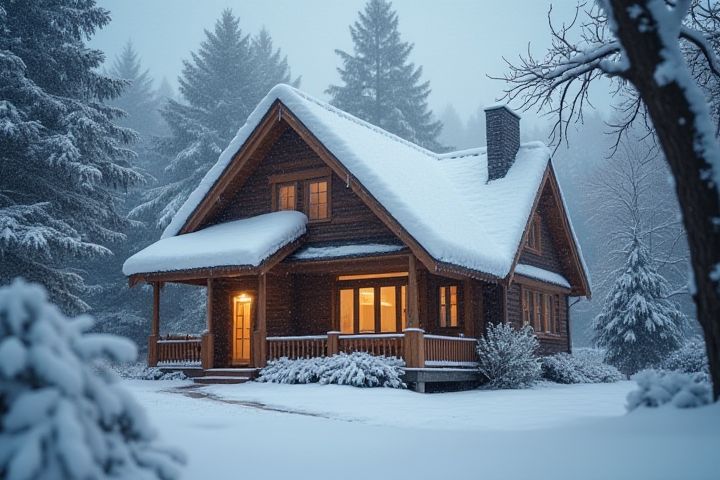
A cold house can be attributed to several factors, including inadequate insulation, which allows heat to escape through walls, roofs, and floors. Drafts from windows and doors can also contribute to a chilly atmosphere, as gaps allow cold air to enter and warm air to exit. Your heating system might be inefficient or improperly sized, leading to insufficient warmth during colder months. Moreover, the orientation of your house can impact its exposure to sunlight, with some areas receiving less natural heat. Finally, humid conditions can make the air feel colder, emphasizing the feeling of chill in your living space.
Why Is My House So Cold
Poor insulation
Poor insulation can significantly contribute to your house feeling cold, as it allows heat to escape and cold air to penetrate. Insulating materials, such as fiberglass, foam board, or spray foam, are crucial in maintaining a comfortable temperature by reducing air leaks and thermal bridging. If your walls, attic, or basement lack proper insulation, you may encounter increased energy bills as your heating system works harder to maintain warmth. To enhance your home's comfort and energy efficiency, consider evaluating and upgrading your insulation to seal off any gaps or weak points.
Drafty windows
Drafty windows can significantly decrease your home's energy efficiency, leading to uncomfortable cold spots. Up to 30% of a household's heating costs may be attributed to air leaks around windows and doors, making proper insulation crucial. You might notice cold air seeping in through gaps or worn seals, which can lower the indoor temperature by several degrees. Addressing these issues by caulking, weather-stripping, or investing in energy-efficient windows can improve comfort while reducing heating expenses.
Inadequate heating system
An inadequate heating system can lead to a consistently cold house, particularly in winter months. If your heating system, such as a furnace, heat pump, or boiler, is undersized for your home's square footage, it will struggle to maintain a comfortable temperature, especially in extreme weather. Moreover, an outdated or poorly maintained system may have efficiency ratings below 80%, resulting in increased energy bills while failing to adequately warm your living space. Regular maintenance, such as cleaning filters and inspecting ducts, can enhance performance, but if your system is incompatible with your home's needs, considering an upgrade for better heating efficiency is essential.
Leaky doors
Leaky doors can significantly contribute to your house feeling cold, as they allow cold air to infiltrate while warm air escapes. Gaps around the door frame, worn-out weather stripping, or improperly fitted doors increase drafts, making your heating system work harder to maintain a comfortable temperature. Insulating your doors with door sweeps or storm doors can effectively reduce heat loss and improve energy efficiency. Regular maintenance and proper sealing not only enhance comfort but can also lower your energy bills in the long run.
Closed or blocked vents
Closed or blocked vents can significantly impact the temperature inside your house, leading to cold rooms and uneven heating. According to the U.S. Department of Energy, even 20% blockage can reduce airflow, causing your heating system to work harder and increasing energy bills by up to 30%. Inspecting each vent for obstructions like furniture or dust buildup is essential to ensure proper airflow. Making sure your vents are open and unblocked can create a more comfortable living environment and improve the efficiency of your heating system.
Unsealed attic
An unsealed attic is a significant factor contributing to your house's cold temperatures, as it allows warm air to escape and cold air to enter. This space often lacks proper insulation, which can create drafts and result in heat loss during colder months. Sealing your attic can not only improve your home's energy efficiency but also maintain a more consistent and comfortable indoor temperature. You might consider adding insulation or using weather stripping to air-seal any gaps, effectively reducing heat loss and enhancing overall comfort.
Faulty thermostat
A faulty thermostat can significantly affect your home's temperature, making it feel colder than desired. If your thermostat is reading inaccurately, it might not activate your heating system when needed, resulting in a chill in your living space. Regular maintenance, such as replacing batteries and ensuring proper calibration, can help prevent issues; 10% of heating problems stem from thermostat malfunctions. You may want to consider upgrading to a smart thermostat, which can optimize energy usage and maintain a more consistent temperature throughout your home.
Lack of weather stripping
A significant reason your house may feel cold could be the lack of proper weather stripping around doors and windows. Insufficient or deteriorating weather stripping can lead to a temperature drop of up to 30% in your home, allowing cold air to infiltrate while warm air escapes. This simple yet crucial barrier helps maintain your home's internal temperature, saving you money on heating bills; for example, effective weather stripping can reduce energy costs by as much as 15%. Consider inspecting and replacing any worn or missing weather stripping to enhance your home's insulation and comfort.
Thin or missing curtains
Thin or missing curtains can significantly contribute to a cold house by allowing heat to escape and cold drafts to enter. Insufficient window coverings reduce thermal insulation, making it easy for chilly air to penetrate from outside. Installing thicker, energy-efficient drapes or adding thermal liners can help retain warmth and improve your home's energy efficiency. If you notice frequent drafts, consider investing in window treatments that enhance insulation properties, ensuring a cozier living environment.
Cold flooring
Cold flooring often results from inadequate insulation or poor heating systems, contributing to an overall chill in your home. A concrete slab or tile floors can feel particularly frigid during winter months, as these materials absorb and retain cold temperatures. To enhance warmth, consider installing area rugs or thermal underlays, which can improve comfort by providing a barrier between your feet and the cold surface. Regular maintenance of your heating system, along with sealing drafts around windows and doors, can further help maintain a cozy indoor environment.
